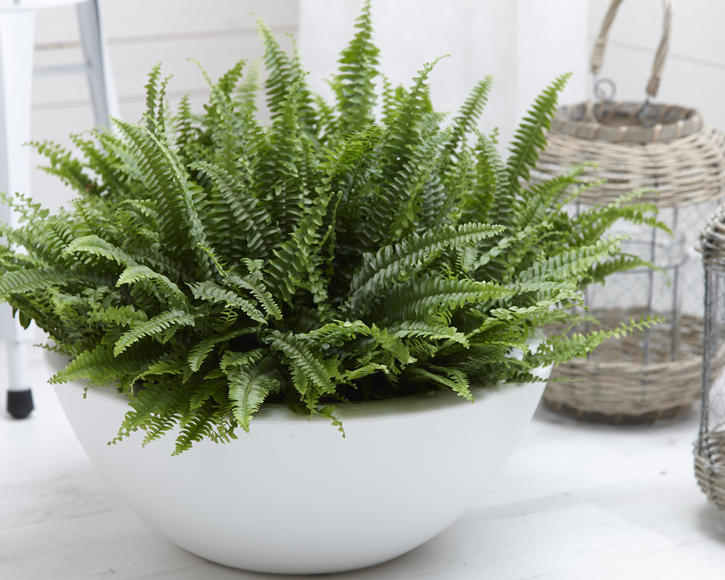Sword fern
The sword fern forms light green, delicate fronds and ensures a good room climate. How to plant and care for the houseplant.
Factsheet
- Growth type
-
- Fern
- Growth characteristics
-
- upright
- overhanging
- horst-forming
- Leaf color
-
- green
- page format
-
- pinnule
- long
- sickle-shaped
- duster
- Sheet properties
-
- evergreen
- Rosette
- Light
-
- scattered light
- Soil Moisture
-
- fresh to humid
- Lime compatibility
-
- sensitive to lime
- Nutrient requirements
-
- low in nutrients
- Humus
-
- rich in humus
- Decorative or utility value
-
- Leaf ornaments
- picturesque growth
- Use
-
- Interior greening
- Planters
- Garden style
-
- Pot garden
The Sword fern (Nephrolepis exaltata) is a houseplant from the Sword fern (Nephrolepidaceae) family, which includes around 30 species. Nephrolepis exaltata is the most common species and originates from tropical forests where it generally grows as an epiphyte on other plants in more swampy areas. The Sword fern has been cultivated in gardens for almost 200 years. It likes to filter harmful substances, such as formaldehyde, out of the air and in this way contributes towards improving the room climate with its decorative, light green fronds. Whether in the office, in a light bathroom or another light, warm spot in the house: Nephrolepis exaltata is one of the most popular houseplants.
The Sword fern is an evergreen, persistent plant which grows as an upright to overhanging Fern and forms a dense clump. The fronds spring from an underground, upright growing rhizome and are arranged in a grounded rosette.
The light green fronds of Nephrolepis exaltata grow up to 3 feet long. The fronds have sickle-shaped leaflets around 1.97 inches long and 0.39 inches wide. Depending on the variety, they can also be twisted, wavy or curled.

It forms warty and wrinkled spores.
The Sword fern requires a light, warm, and partially sunny location, although it should be protected from direct sunlight. Nephrolepis exaltata should be kept at room temperature - even in the winter, the temperature should not fall below 64.4 degrees Fahrenheit. Moreover, a humid spot is ideal - which is why a light bathroom is a particularly good location due to its high humidity. You should avoid putting it in places in the house where it is exposed to drafts or heating air. The sword fern does not like that at all. With its overhanging fronds, the fern is a perfect evergreen and exotic hanging basket plant, which looks particularly good on columns or pedestals.
Good quality potting soil with relatively low nutrients is the best substrate for the Sword fern. In addition, mixtures of compost and leaf mold have proven suitable.
You should keep Nephrolepis exaltata moderately but consistently moist and avoid waterlogging. The soil should always have a loose consistency. The houseplant will tolerate short spells of dryness, but this will lead to it dropping leaflets. Only water the plant with soft water so that the leaves do not develop calcium marks, and spray the leaves occasionally. Also ensure the room has relatively high humidity.
During the growing period you should fertilize the Sword fern once a week. In the winter it should be given nutrients less frequently - at the most every four weeks.
It is sufficient to re-pot Nephrolepis exaltata approxiamately every two to three years in normal potting soil. The best time for this is spring.
It is not generally necessary to cut back the Sword fern.
In dry air there is a risk that the Sword fern will become infested with spider mites and drop its leaves. Therefore, the tropical plant should be sprayed regularly. It can also be useful to place bowls full of water close to the fern in order to increase the humidity in the room. The Sword fern will also drop its leaves in dark places. In this case, the only thing that will help is to move it to a different place, for example a west-facing window.

There are many decorative types of this desirable house fern available. There are Sword fern varieties with wavy, curled or twisted fronds as well as very old breeds.
Nephrolepis exaltata ‘Boston’, also known as Boston fern, is a variety with light green, simple pinnate fronds and upright growth. ‘Boston dwarf’ is a variety which remains small and grows upright. ‘Teddy Junior’ is a resilient variety with wavy, slightly round leaflets. ‘Roosevelt Plumosa’ is a large variety with curled leaflets. ‘Bornstedt’ has multiple, finely pinnate fronds with rounded tips at the front. ‘Variegata’ is a type with white-green variegated fronds. ‘Massii’ has compact growth and is simply pinnate. ‘Green Lady’ has bushy, overhanging growth; it is a variety with heavily pinnate leaves. ‘Harrisii’ forms simply pinnate, wavy fronds.
The Sword fern is best propagated through division or offshoots. Filimentary offshoots on which small plants form are separated in the summer and placed in small pots.
Spider mites may appear on Nephrolepis exaltata in dry air. Brown leaf tips can result from dry air, ball dryness or waterlogging. Yellow leaves indicate the temperature of the location is too low.

